To Comply or Not to Comply: A Few Stories
Critique Groups
We write by ourselves—pouring our hearts and ideas out onto the page. Then we bring those heart-filled pages to our writing group. Hopefully they support us and want the best for us. But the whole point is to improve our writing, so the members critique— after all it is a critique group. They question us. What is your main purpose? Someone asks, Is this phrase really what you want to say? Or, This structure confuses me. Or, perhaps the worst, This is fatally flawed.
When yours is the work being critiqued, you listen carefully. If you have an ongoing group you learn each member’s strengths in critiquing as time goes on. This one is good with rhythm and sound. This one is a librarian and knows the literature. This one is the grammarian. But this other one knows the main character’s voice doesn’t need to be grammatical. You don’t disregard anyone’s feedback—whether they’re published or not. Sometimes the least experienced person in your group has a clarity that turns out to be the most helpful of all.
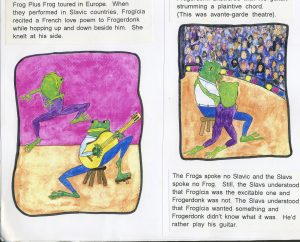 You take notes during the meeting. You go home and pore over the written comments, whether on paper or in e-documents. I take the one paper version that speaks to me most clearly (or is the cleanest, or attracts me for some reason) and then I assign a color for each critiquer and add their notes to the document. If two or more people have the same comment, I take that comment especially seriously. I return to my color key to remind myself who else made similar comments. I know my critiquers. I respect my critiquers. We’ve grown up together as writers and have gotten published over time. Some are pre-published. Yes, some people move away, but we usually remain friends. New people occasionally join. We help each other.
You take notes during the meeting. You go home and pore over the written comments, whether on paper or in e-documents. I take the one paper version that speaks to me most clearly (or is the cleanest, or attracts me for some reason) and then I assign a color for each critiquer and add their notes to the document. If two or more people have the same comment, I take that comment especially seriously. I return to my color key to remind myself who else made similar comments. I know my critiquers. I respect my critiquers. We’ve grown up together as writers and have gotten published over time. Some are pre-published. Yes, some people move away, but we usually remain friends. New people occasionally join. We help each other.
It’s understood that as a critiquer you’re expressing opinions. So much is simply subjective. One suggestion or marked problem might contradict another critiquer’s suggestion. You know that the one being critiqued won’t do everything you suggest. It’s their piece, guided by their vision. So the buck stops at the writer. It’s up to you—the writer—to figure out the right path.
Submissions to Agents or Editors
When you or your group think it’s time to send your work to an editor or an agent, you ready yourself to receive further suggestions or advice, from the editing professionals. If the editor or agent likes your work enough to ask you to revise, that’s great. They’re interested. Hoorah! You’re making progress. But what if the advice makes no sense to you, or you’re opposed to the changes?
Now let’s get personal. Here are some stories, starting with my own.
My background is that of a dancer/ choreographer who was the chief cook and bottle washer for my dance company, One Plus One. Well, actually I was dancer, choreographer, booking agent (sometimes), and oftentimes costume designer, lighting designer, travel guide, grant writer, and who knows what else! 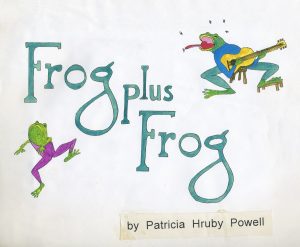 I was NOT accustomed to others telling me how something should be done. Walter Lorraine at Houghton Mifflin said he might buy my picture book titled Frog Plus Frog if I made a story out of it. Hmmm…It felt like a story to me. It was the story of my internationally touring dance company, told in “Frog” and illustrated by me. I revised, trying to make it more of a “story.” Perhaps I still didn’t understand what Mr. Lorraine meant by “story.” Anyway, I didn’t change it to his satisfaction. He told me I was stubborn. True. But I’d tried. It was never published.
I was NOT accustomed to others telling me how something should be done. Walter Lorraine at Houghton Mifflin said he might buy my picture book titled Frog Plus Frog if I made a story out of it. Hmmm…It felt like a story to me. It was the story of my internationally touring dance company, told in “Frog” and illustrated by me. I revised, trying to make it more of a “story.” Perhaps I still didn’t understand what Mr. Lorraine meant by “story.” Anyway, I didn’t change it to his satisfaction. He told me I was stubborn. True. But I’d tried. It was never published.
I wrote an autobiographical novel of my eleven-year-old self, titled Maddy (get it, Patty/Maddy?). Editor Wendy Lamb, then, an editor at Penguin, said, Do this and this and this and I’ll look at it again. I tried half-heartedly, but I didn’t really want to do this and this and this. I liked my book the way it was. Virginia Buckley of Clarion and Robbie Mayes of FSG each asked me to make revisions I didn’t want to do or didn’t understand. I sort of tried. They both declared it publishable—but not by them. It was never published. Who knew it would be so difficult to get published?
I submitted a collection of retold flower folktales, Bloom Tales, to Charlesbridge. An editor there told me that if I chose Writing Tips To Comply or Not to Comply: A Few Stories 14 other simple folktales and retold them briefly such that each could be an illustrated double-page spread, she’d love to look at that. But that wasn’t what I wanted to do. Who knew it was this difficult to get published?
So a few years later I tried what that editor had suggested and sent it to her, but by then she’d left the house. And no one else at Charlesbridge wanted it. Publishing is a subjective matter too— and therefore placing a manuscript is partly luck.
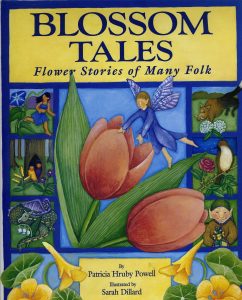 Eventually that manuscript of brief folktales became my first book, Blossom Tales: Flower Stories from Around the World (Moon Mountain 2002), beautifully illustrated by Sarah Dillon. Sadly, Moon Mountain is now defunct. But the lesson is: Those editors are smart. They know what they’re talking about. Today, most manuscripts have to go through agents to get to editors, but those agents know their stuff too, and might also suggest revisions.
Eventually that manuscript of brief folktales became my first book, Blossom Tales: Flower Stories from Around the World (Moon Mountain 2002), beautifully illustrated by Sarah Dillon. Sadly, Moon Mountain is now defunct. But the lesson is: Those editors are smart. They know what they’re talking about. Today, most manuscripts have to go through agents to get to editors, but those agents know their stuff too, and might also suggest revisions.
So if you want to get published, I’d suggest you do what those smart and knowledgeable editors and agents suggest. But how can you do that if your heart isn’t in it? Next question: Am I sorry I didn’t comply? I was disappointed to not get those early manuscripts published, but I kept working, persevering, improving my work. As with any art, by practicing diligently you improve your skills. After Blossom Tales I published two retold Navajo folktales with Salina Bookshelf, wonderfully illustrated by the Navajo artist Kendrick Benally.
Let’s look at some other authors’ stories—members of SCBWI-Illinois who complied and got published. They’re not necessarily compliant but they did end up complying. And so became published authors—probably sooner in their careers than I, a noncomplier, did.
Sallie Wolf had a manuscript critiqued at a local conference. The editor liked her writing but didn’t want  the piece Sallie had submitted. The editor wanted a truck piece. Sallie set to writing it on her ‘L’ trip home—a different truck for each day of the week. The editor said, “Wrong age group, trucks are for toddlers, focus on your audience”. Sallie complied, rewrote, sent it in. After nine months she called the editor. The editor asked her to rewrite it in rhymed couplets and gave her a first couplet as a model. OK, said Sallie.
the piece Sallie had submitted. The editor wanted a truck piece. Sallie set to writing it on her ‘L’ trip home—a different truck for each day of the week. The editor said, “Wrong age group, trucks are for toddlers, focus on your audience”. Sallie complied, rewrote, sent it in. After nine months she called the editor. The editor asked her to rewrite it in rhymed couplets and gave her a first couplet as a model. OK, said Sallie.
Four years after that ‘L’ ride Peter’s Trucks was published (Albert Whitman 1992). Sallie then wrote Truck Stuck, which Whitman rejected, and twelve short years later 😉 it came out with Charlesbridge (2008). (Sallie did not give 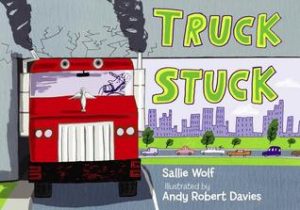 up). Sallie complied. She believed some smart editors and improved her stories as she worked with them.
up). Sallie complied. She believed some smart editors and improved her stories as she worked with them.
There are lots of similar stories. Frequently an editor will ask for a revision, the author will comply, and yet no contract is offered. Most authors feel they vastly improve their manuscripts by working with an editor who cares. So what if, after all that work, no contract is offered? Oftentimes it will sell to another publisher. That’s what happened with my Lift As You Climb: The Story of Ella Baker (McElderry—Simon & Schuster 2020). I 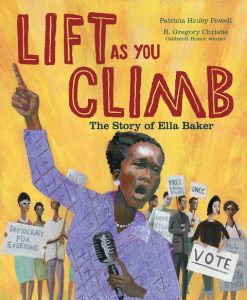 worked with an editor from one house. We radically improved my manuscript. We worked great together. But she couldn’t get it through acquisitions— you know, that’s when the editor brings the work to the editorial, marketing, and maybe art staff meeting—where they decide on whether to offer a contract. Shortly after, my agent sold this manuscript to Simon & Schuster and there was practically no editing to be done (I’d already done it).
worked with an editor from one house. We radically improved my manuscript. We worked great together. But she couldn’t get it through acquisitions— you know, that’s when the editor brings the work to the editorial, marketing, and maybe art staff meeting—where they decide on whether to offer a contract. Shortly after, my agent sold this manuscript to Simon & Schuster and there was practically no editing to be done (I’d already done it).
Sara Shacter spent a year revising her novel for an agent. Though the agent ultimately passed, the manuscript had improved  immensely and Sara snagged another agent.
immensely and Sara snagged another agent.
Carol Grannick made six huge revisions to her novel for one agent, who finally felt she’d nailed it, but the agent failed to sell the book. They parted 15 ways. So Carol  returned to her original concept, made improvements to the story, and sold it. Ta da! Sometimes what an editor or agent wants isn’t what the book you’re writing necessarily needs to find its home. Carol’s vision held strong. Look for Reeni’s Turn (Regal House/Fitzroy Books, 2020). Yeah, Carol!
returned to her original concept, made improvements to the story, and sold it. Ta da! Sometimes what an editor or agent wants isn’t what the book you’re writing necessarily needs to find its home. Carol’s vision held strong. Look for Reeni’s Turn (Regal House/Fitzroy Books, 2020). Yeah, Carol!
I do love working with an editor whose ideas make sense to me. But I’m still stubborn. My agent has been placing my work for ten years now. We do well together. But recently, she was confused by the structure of a manuscript I submitted to her. She asked me to do something that baffled me. Each day I’d look at her preferred structure and each day I’d close my computer and go off to clean my deck, organize my office. Or play Wordscapes on my phone. After a week or so, I asked my (editing) agent to submit the piece as I’d organized it, to the four editors who have bought recent works of mine. I wondered if she’d drop me, but I couldn’t do what she’d asked. After a few days of silence, she agreed. If it turns out all four of those editors are perplexed by my work, I’ll go back to the drawing board. It was risky. But I simply couldn’t do what my agent wanted—it was no longer my piece with my ideas if I restructured it.
Post Contract
Even after you have a contract (Yay! Congratulations! Fireworks! Cocktails!) editors inevitably ask you for revisions. Sometimes you fully comply and sometimes you don’t. They expect this. Editors respect 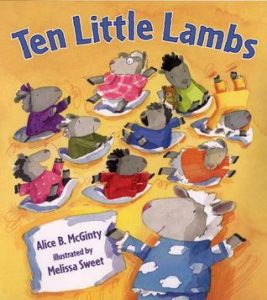 their writers.
their writers.
In Alice McGinty’s first trade book, Ten Little Lambs (Dial 2002), there was the mention of underwear. The editor did not like the underwear. Alice said something to the effect of, “Please, I want the underwear. Kids love underwear.” But it was a first book and as Alice says, “You pick your battles.” That underwear became pajamas.
In another of Alice’s books, the marketing department created a title that simply didn’t work for Alice. Every day she’d suggest an alternate title. Finally they agreed on the title Eliza’s Kindergarten Surprise (Marshall Cavendish 2007). You pick 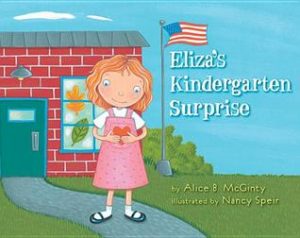 your battles.
your battles.
My editor wanted a metaphor of fabric to run through Loving vs. Virginia (Chronicle 2017) in the same way I’d used a volcano metaphor in Josephine (Chronicle 2014). I couldn’t make it work. But I kept a few references to home-spun cloth and fabric, which deepened the tactile sense in the story. Sometimes (or maybe always) an editor requests changes because she thinks something is missing from the work— but there are various ways to address what might be missing. What they want is for your book to work in the  best way possible.
best way possible.
If you’re not yet published, is it because you’re still developing your style, your work? The stories above are just a few sample situations. Walter Lorraine was correct. I’m stubborn—not just due to my experience as chief cook and bottle washer, but stubbornness is a deeply hewn character trait of mine. I like to think of it as being strong-willed 😉
We make decisions about our work at every turn. And when we let others into the mix—critique group members, agents, editors, our readers—we open ourselves up to even more decisions that must be made. No one can tell you with certainty when to comply and when not to, but maybe these stories can help guide you when you face your own struggles with editorial demands. To comply or not to comply, that is often the question.
Please share your inspiring (or not-inspiring) stories or ask questions or advice from this knowledgeable group of Illinois SCBWI members.
Patricia Hruby Powell teaches continuing education writing classes at Parkland College in Champaign. She tends to feel a strong ownership of her writing, but loves to work with editors whom she admires and respects and who can guide her in improving her books, which currently include Struttin’ With Some Barbecue; Loving vs. Virginia; and Josephine: The Dazzling Life of Josephine Baker.
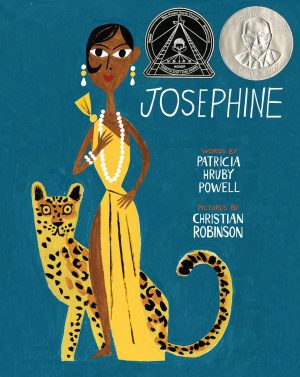

Leave a Reply